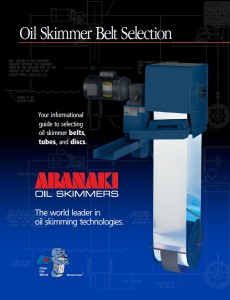 Click here to receive the newly updated Oil Skimmer Belt Selection Guide. With this informational guide you will have access to diagrams of all of Abanaki's oil skimmers and how to properly size a belt for each skimmer.
Click here to receive the newly updated Oil Skimmer Belt Selection Guide. With this informational guide you will have access to diagrams of all of Abanaki's oil skimmers and how to properly size a belt for each skimmer.There are many variables in an application that will dictate which oil skimmer and belt material will work best in removing hydrocarbons from fluids. Determining the suitability for an oil skimming application is extremely important for an effective solution to the hydrocarbon problem. In outdoor applications, the use of heaters may be required to keep skimmed product fluid so it can be effectively removed from the medium and collection tray. This is particularly true for grease skimming, which involves higher viscosity at all temperatures. Polymer materials are limited in their heat tolerance, so skimmers equipped with these media may have only tray heaters. Skimmers with steel media can apply heat to both the tray and the medium, which improves performance in severe winter climates. To resist corrosion, a stainless steel housing also may be needed. Above ground enclosures and underground manway mounting kits provide additional protection from the elements.
Commonly used materials for wiper blades are nitrile, [CRV] and ceramics. Nitrile is suitable for use as high as 176° F in neutral pH liquids. For higher temperatures and acidic or alkaline liquids, [CRV] wipers work well. Ceramics are resistant to more chemicals, but are prone to breakage.
For hazardous duty locations with ignitable fumes, explosion-proof motors are mandatory. Special corrosion resistant motor housings may be required for sanitary washdown situations in food plants. Different voltages and power frequencies are needed for some plants.
In many applications, skimmers can run unattended for days or weeks. This is typical for groundwater remediation applications at remote well sites. When controls are used, they tend to be either manual on/off switches or 24-hour timers to start and stop the unit at predetermined times.
If you have further questions about your application’s suitability for oil skimming, click the photo below to access our new interactive oil skimmer selection guide. Find the right skimmer for your application!



